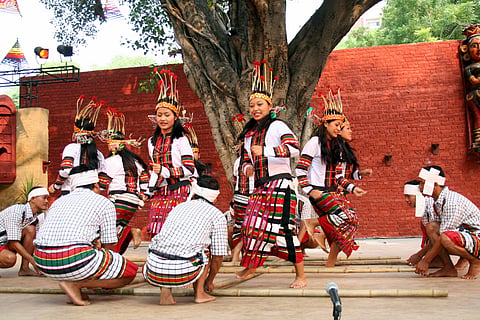
- Destinations
- Experiences
- Stay
- What's new
- Celebrating People
- Responsible Tourism
- CampaignsCampaigns
- Subscribe
- Buy Now

For the longest time, Mizoram has made headlines for being one of the most beautiful states constituting diverse customs and cultures. The Mizo community has historically been attuned to agriculture and their natural surroundings. This oneness with nature is reflected in Chapchar Kut, one of Mizoram's many festivals that marks the onset of spring. The festival entails spirited dances, traditional music and group feats. It makes for an insightful window in Mizo culture and proves educational for the outsider's gaze.
The word "Chapchar Kut" is derived from two Mizo words: chapchar, which encapsulates the time of the year when cut bamboos and trees are being dried; and kut, implying celebration. The origins of this celebration is traced to the town of Suaipui, which existed between 1450 and 1600 AD. Oral legends suggest that the event started with hunters returning from their expeditions with sparse gatherings. The village leader would throw a spontaneous feast with plenty of meat and rice beer to lift everyone's spirits. Thus, Chapchar Kut was born chiefly as an impromptu festival that turned disappointment into joy. Over time, this festival evolved into an annual occasion.
Traditionally, Chapchar Kut was observed in the window between the start of seasonal sowing and the clearing of forests for jhum cultivation. The community took respite during this period, enabling them to celebrate, hunt, and indulge in recreational gathering. In addition, it is also treated as a symbolic celebration of the transition from the biting winter to warmer spring, representing hope and bounty.
The celebrations and rituals that comprise Chapchar Kut are characterised by a series of vibrant activities that showcase the rich cultural heritage of the Mizos. For instance, you'd witness the famous and highly anticipated Cheraw Dance, or Bamboo Dance. The dance involves female dancers who step gracefully between moving bamboo poles held in place by male participants. The rhythmic clapping of the poles and the synchronised movements of the dancers produces a mesmerising spectacle.
Where Chapchar Kut dances are concerned, it would be criminal to miss the Chai Dance. In this dance, participants form a human circle linking arms together and swaying to traditional songs and beats. The dance fosters communal harmony.
People also observe Khuallam, which is, loosely put, a dance of the guests. It is performed to welcome visitors where dancers in traditional attire execute an energetic show in rhythm with the beats of drums and gongs. Chheihlam is yet another one of the dance styles which involves a relaxed setting—often around a hearth—where participants sing and dance, reflect on stories and experiences, and foster community bonding.
Chapchar Kut is also marked by traditional feasts. They are an integral part of the festival with dishes made from meat and other local ingredients. Historically, rice beer (zu) flows freely during the celebrations, enhancing the festive spirit. However, in contemporary times, with the influence of Christianity and the state's dry laws, the consumption of alcohol has been curtailed.
The event, which usually lasts four to five days, starts with the slaughtering and feasting of pigs and continues with days of singing, dancing and rice beer consumption. On the third night, rice beer is served while young men and women dressed in traditional finery dance in circles. Families enjoy Zupui, a light rice beer, on the fourth day while cultural performances go on. The fifth day is devoted to consuming the last of the beer, while the sixth day is set aside for relaxation, with neither work nor hunting permitted. In villages like Chawngtui, festivities last until jhumming time, forcing villagers to disperse. Similarly, at Ruallung, the Chai Dance once continued uninterrupted until a parrot dropped an ear of paddy, signalling harvest time.
Chapchar Kut and other cultural celebrations were forbidden after Christianity arrived in Mizoram in 1894 because of their associations with drinking and animistic rituals. Because they feared it might drive converts back to their old ways, churches in Aizawl and Lunglei prohibited participation. However, opinions changed as Mizos became more educated and exposed to the outside world. People realised that maintaining cultural customs did not have to conflict with religious beliefs. In order to ensure that Chapchar Kut continues to be an essential component of Mizoram's legacy, it is commemorated in a sophisticated manner today that strikes a balance between tradition and contemporary values.
In order to keep the younger generation connected to their heritage, Chapchar Kut is now commemorated annually, typically on the first Friday of March, with lively cultural performances that include traditional dances, music, and clothing. Mizo handlooms and indigenous crafts are displayed by artists during art and craft shows, and the community's passion for competition is reflected in traditional sports and pastimes. A wonderful presentation of Mizoram's rich cultural character, the event is made more festive by the unique Mizo dishes served at the cuisine stalls.
